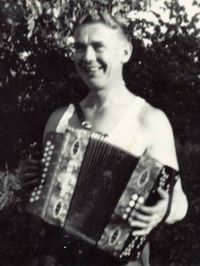Annotation:Hot Punch (1): Difference between revisions
No edit summary |
m (Text replacement - "garamond, serif" to "sans-serif") |
||
| Line 1: | Line 1: | ||
=='''Back to [[{{BASEPAGENAME}}]]'''== | =='''Back to [[{{BASEPAGENAME}}]]'''== | ||
---- | ---- | ||
<p><font face=" | <p><font face="sans-serif" size="4"> | ||
'''HOT PUNCH [1]'''. AKA and see "[[Blue Bonnets Hornpipe]]," "[[Frolic (The)]]," "[[Orange and Blue (2)]]," "[[Lick the Laddle Sandy (2)]]," "[[Queen's Marriage (The)]]." Scottish, Jig. D Major. Standard tuning (fiddle). AB. Usually known as "Orange and Blue," by which title it is widely printed. The word 'punch' derives from a Hindi word, panch, meaning 'five', because of its five ingredients: spirits, water, lemon-juice, sugar and spices. The word was first recorded in English in 1669. 4/4 time versions of the melody go under the title "[[Frolic (The)]]" (e.g. William Vickers), among others (see alternates, above). The tune was popularlized in the mid-20th century by melodeon player Bob Cann (Dartmoor). | '''HOT PUNCH [1]'''. AKA and see "[[Blue Bonnets Hornpipe]]," "[[Frolic (The)]]," "[[Orange and Blue (2)]]," "[[Lick the Laddle Sandy (2)]]," "[[Queen's Marriage (The)]]." Scottish, Jig. D Major. Standard tuning (fiddle). AB. Usually known as "Orange and Blue," by which title it is widely printed. The word 'punch' derives from a Hindi word, panch, meaning 'five', because of its five ingredients: spirits, water, lemon-juice, sugar and spices. The word was first recorded in English in 1669. 4/4 time versions of the melody go under the title "[[Frolic (The)]]" (e.g. William Vickers), among others (see alternates, above). The tune was popularlized in the mid-20th century by melodeon player Bob Cann (Dartmoor). | ||
[[File:Bobcann.jpg|200px|thumb|left|Bob Cann (1917-1990)]] | [[File:Bobcann.jpg|200px|thumb|left|Bob Cann (1917-1990)]] | ||
| Line 7: | Line 7: | ||
<br> | <br> | ||
</font></p> | </font></p> | ||
<p><font face=" | <p><font face="sans-serif" size="4"> | ||
''Source for notated version'': | ''Source for notated version'': | ||
<br> | <br> | ||
<br> | <br> | ||
</font></p> | </font></p> | ||
<p><font face=" | <p><font face="sans-serif" size="4"> | ||
''Printed sources'': Callaghan ('''Hardcore English'''), 2007; p. 59. | ''Printed sources'': Callaghan ('''Hardcore English'''), 2007; p. 59. | ||
<br> | <br> | ||
<br> | <br> | ||
</font></p> | </font></p> | ||
<p><font face=" | <p><font face="sans-serif" size="4"> | ||
''Recorded sources'': <font color=teal>HEBE Music HebeCD002, Flowers and Frolics - "Reformed Characters." Veteran VT138CD, Bob Cann - "Proper Job!: Melodeon playing from Dartmoor recorded 1952-1988."</font> | ''Recorded sources'': <font color=teal>HEBE Music HebeCD002, Flowers and Frolics - "Reformed Characters." Veteran VT138CD, Bob Cann - "Proper Job!: Melodeon playing from Dartmoor recorded 1952-1988."</font> | ||
</font></p> | </font></p> | ||
Revision as of 13:25, 6 May 2019
Back to Hot Punch (1)
HOT PUNCH [1]. AKA and see "Blue Bonnets Hornpipe," "Frolic (The)," "Orange and Blue (2)," "Lick the Laddle Sandy (2)," "Queen's Marriage (The)." Scottish, Jig. D Major. Standard tuning (fiddle). AB. Usually known as "Orange and Blue," by which title it is widely printed. The word 'punch' derives from a Hindi word, panch, meaning 'five', because of its five ingredients: spirits, water, lemon-juice, sugar and spices. The word was first recorded in English in 1669. 4/4 time versions of the melody go under the title "Frolic (The)" (e.g. William Vickers), among others (see alternates, above). The tune was popularlized in the mid-20th century by melodeon player Bob Cann (Dartmoor).

Source for notated version:
Printed sources: Callaghan (Hardcore English), 2007; p. 59.
Recorded sources: HEBE Music HebeCD002, Flowers and Frolics - "Reformed Characters." Veteran VT138CD, Bob Cann - "Proper Job!: Melodeon playing from Dartmoor recorded 1952-1988."
